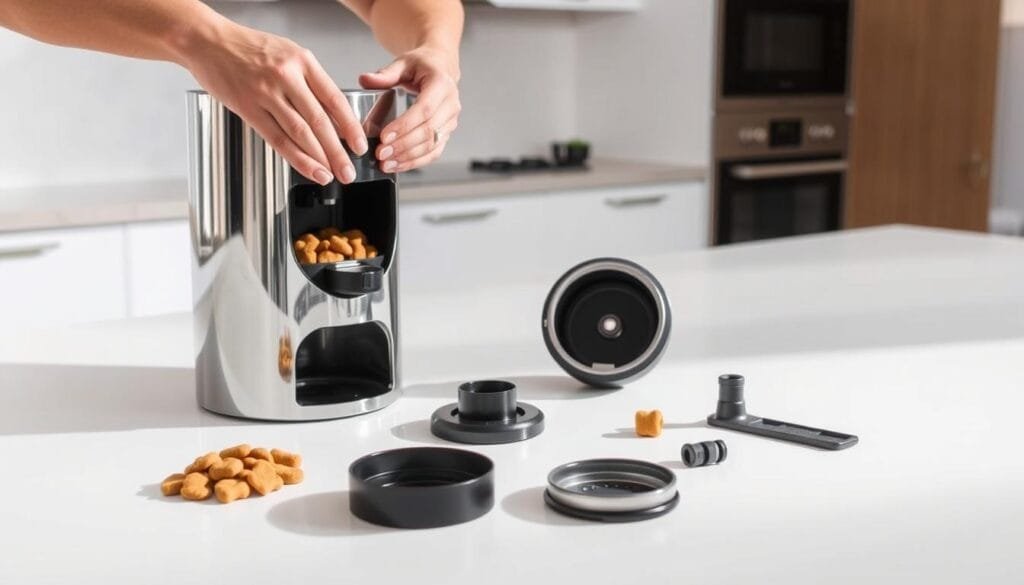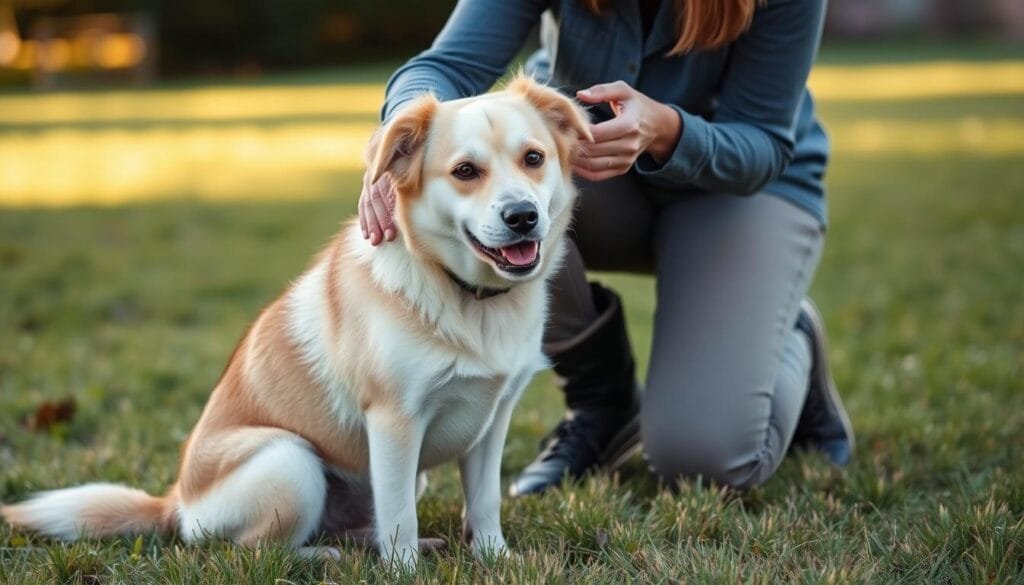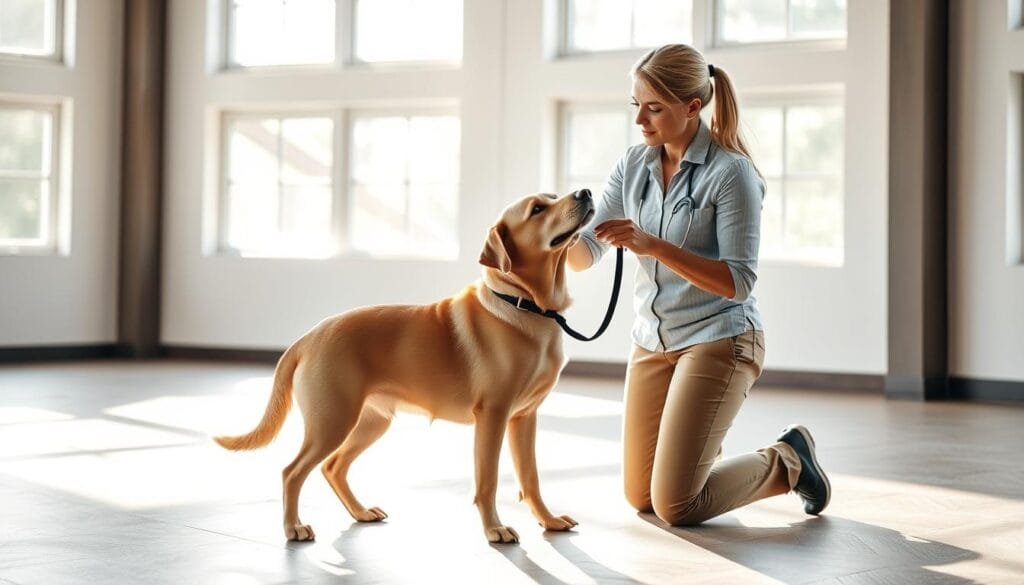Tellington Touch: Transformative Techniques for Pet Care
“The greatest pleasure of a dog is that you may make a fool of yourself with him, and not only will he not scold you, but he will make a fool of himself, too.” – Samuel Butler
Explore the world of Tellington Touch (TTouch), a groundbreaking pet therapy. It changes how we care for animals. This gentle animal massage method helps with behaviour and strengthens the bond between pets and their owners.
Linda Tellington-Jones created TTouch in 1975. It’s a unique way to understand and support animals. Unlike traditional training, TTouch focuses on holistic healing and emotional connection using pet calming techniques for behavioural rehabilitation.
In Ireland and worldwide, pet owners see amazing changes. It helps with anxiety, reactivity, and boosts overall well-being. Tellington Touch offers a kind solution.
Key Takeaways
- Tellington Touch is a holistic complementary healing pet therapy method
- Addresses multiple behavioural and emotional challenges
- Developed by Linda Tellington-Jones in 1975
- Focuses on gentle, mindful animal interaction
- Effective for dogs of all ages and breeds
- Promotes physical and emotional balance
Understanding the Origins of TTouch Method
The TTouch method changed how we care for pets and dog welleness. It’s a new way of massaging animals and looking at their health. Linda Tellington-Jones started this, changing how we see our pets.
The TTouch method started in 1975. Linda knew a lot about animals and how to help them. She was inspired by the Feldenkrais method, which focuses on body awareness and puppy wellness.
A Visionary’s Approach to Animal Care
Linda Tellington-Jones saw animals in a new light. She wanted to help them in many ways. Her method helps with:
- Physical rehabilitation
- Emotional healing
- Behavioural transformation
- Stress reduction
She believed that touch can really help animals. By linking body and mind, she made a system that supports animals’ health and happiness.
Innovative Techniques and Philosophical Foundations
The TTouch method uses special touches to talk to animals. It’s different from old ways of training. It focuses on:
- Mindful communication
- Gentle, purposeful touch
- Emotional and physical healing
Linda showed that TTouch can help animals with many problems. It’s a big step forward in caring for animals.
The Science Behind Tellington Touch
Tellington Touch is a new way to talk to animals through touch. It changes their behaviour by touching their nervous system. This is different from old training methods.
This method is based on science and helps animals in a special way. It uses touch to wake up their nervous system and make their cells work better. The touch is soft and circular, helping animals feel and learn better.
- Circular movements range from pressure levels 1-10
- Clockwise circles strengthen the body
- Counterclockwise circles release tension
- Pressure levels vary based on animal size and condition
Studies show that TTouch changes important chemicals in animals’ brains. It helps them feel less stressed and more focused. This can really help animals with problems like being too anxious or barking too much.
TTouch aims to transform an animal’s learning potential through gentle, intentional touch.
Science says TTouch can make animals relax and feel closer to each other. It’s a way to really understand and help animals feel better.
Core Principles of TTouch Methodology
A new way of understanding dogs has emerged, focusing on their well-being. The Tellington TTouch® Method offers a fresh view on how to care for puppies. It moves beyond old training methods.
https://www.youtube.com/watch?v=KyO3WY4CuNg
This groundbreaking approach has grown over 40 years. It creates a complete way to support our animal friends. The core ideas are based on three main principles:
- Change Your Mind; Change Your Animal
- Chunk it Down
- Change the Posture; Change the Behaviour
Physical and Emotional Balance Connection
The Tellington TTouch® Method sees a deep link between a dog’s body and mind. Fixing physical issues can improve their mental and emotional health.
Neural Pathway Activation
TTouch uses special bodywork and exercises to create new brain paths. This helps dogs become more aware of their bodies and better at handling different situations.
Mindful Approach to Animal Care
TTouch is different from old training ways. It builds trust and teamwork. It makes learning fun and safe for puppies, reducing fear and pain.
“Change the Posture, Change the Behavior” – A fundamental principle of Tellington TTouch®
These principles can greatly enhance your dog’s life, whether they’re young or old. They’re key to better dog wellness.
Essential TTouch Body Work Techniques
Tellington TTouch is a special way to massage dogs that’s more than just petting. It uses over 30 unique methods to build strong bonds between pets and their owners.
- Clouded Leopard Circle: A soft circular motion with the fingertips
- Llama Touch: Long strokes to help release tension
- Python Lift: A gentle lift to boost body awareness
Each technique has a special role in helping animals. The dog ttouch massage methods aim to:
- Lower anxiety
- Boost body awareness
- Improve emotional balance
These techniques have been developed over 50 years. They are backed by science and focus on making pets feel safe and secure through gentle touch.
| Technique | Primary Benefit | Recommended For |
|---|---|---|
| Clouded Leopard Circle | Stress Reduction | Anxious Dogs |
| Llama Touch | Muscle Relaxation | Tense or Reactive Pets |
| Python Lift | Body Awareness | Rehabilitation Cases |
These TTouch techniques are great for any dog, whether they’re nervous or full of energy. They offer a caring way to support your pet’s physical and emotional health.
Specialised Equipment and Tools in TTouch Practice
TTouch practitioners use special tools to help animals. These tools are key for positive interactions and support the animal’s growth.
Our tools help animals feel more confident and less stressed. Each tool has a special role in improving their well-being.
Body Wraps and Their Applications
Body wraps are a key part of TTouch. They offer:
- Gentle pressure that calms animals
- Help in improving body awareness
- Support in behaviour change
The wrap technique feels like a hug, making animals feel safe and calm during training.
Double-ended Leads and Harnesses
Double-ended leads and special harnesses are vital for animal care. They help:
- Stop pulling during walks
- Improve balance and coordination
- Make communication better
Confidence Course Equipment
Our confidence courses use special obstacles to boost an animal’s confidence. Animals learn:
- More about their space
- Trust in their handler
- How to handle emotions
With these tools, TTouch practitioners offer a full approach to training. It focuses on both physical and emotional growth.
The TTouch Playground for Higher Learning

The TTouch Playground is a new way to talk to animals and help them. It changes how we connect with pets by giving them special experiences. These experiences are different from old training methods.
Our playground has special parts that help animals learn and grow:
- Labyrinth configurations for spatial awareness
- Pole and board exercises
- Confidence-building obstacle courses
- Slow-movement exploration zones
The TTouch Playground works by using non-habitual experiences to engage an animal’s nervous system. It introduces new ways of moving. This helps animals:
- Get better at knowing their body
- Feel more confident
- Manage their emotions better
- Solve problems more easily
Studies show that slow, careful movements in the playground make animals’ brains work differently. This makes them feel happier and learn more.
People who work with pets see the TTouch Playground as a game-changer. It’s a safe place for animals to learn and grow. They can explore and build trust with their owners.
Our playground isn’t just about physical movement—it’s about creating meaningful communication between humans and animals.
Behavioural Transformation Through TTouch
Dealing with pet behavioural issues needs care and new ideas. Tellington TTouch is a key method for tackling tough dog behaviours. It offers a soft yet strong way to heal their emotions.
Our work with calming pets shows TTouch’s big effect on dogs with emotional issues. It links physical touch to mental health, leading to amazing changes in dogs.
Addressing Anxiety and Fear
Dogs with anxiety show small signs that need careful help. TTouch has a special way to tackle these issues by:
- Lowering stress with soft circular movements
- Building a safe, calm way to talk
- Helping them know their body better
Managing Reactivity
Reactive behaviours can hurt the bond between humans and animals. TTouch has special methods to help dogs:
- Control their emotions better
- Manage their impulses
- Feel more confident in tough situations
“The Touch That Teaches” shows how TTouch changes animal behaviour through careful connection.
Building Trust and Confidence
Trust is key in fixing behavioural issues. Our calming pet techniques through TTouch build a strong bond. This helps dogs become more resilient and emotionally stable.
Studies show dogs in TTouch training get better at things like pulling on the leash, being scared, and being aggressive. By focusing on physical, mental, and emotional balance, we help dogs feel more at ease and confident.
Physical Benefits and Healing Applications
Tellington Touch is a gentle yet powerful way to help animals. It aids in physical recovery and boosts wellness. This method helps pets with different health issues by reducing pain and improving movement.
Key physical benefits of TTouch include:
- Improved circulation and healing
- Reduced muscle tension
- Enhanced flexibility in ageing animals
- Support for injury recovery
Studies show TTouch is great for animal wellness. It’s used by over one million people in 46 countries. The method’s circular motion helps the body heal naturally, making it a good addition to vet care.
Many case histories prove TTouch’s success in helping animals with health issues. It’s safe and has no side effects. This makes it a good choice for pet owners looking for holistic health solutions.
TTouch: A gentle touch that speaks volumes about healing and care.
Adding TTouch to pet care routines can greatly benefit animals. It supports their physical and emotional health. This holistic approach goes beyond traditional vet treatments.
Integration with Traditional Training Methods
Dog training has changed a lot in recent years. New methods like Tellington Touch bring fresh ideas to how dogs learn and grow. The TTouch method adds a special touch to traditional positive training, making it more complete.

TTouch believes that learning is more than just repeating things. It takes a full view of a dog’s feelings and body during training.
Complementing Positive Reinforcement
Dogs do best with a mix of training methods. Dog ttouch massage, for example, can make traditional training better by:
- Lowering stress and anxiety during training
- Boosting body awareness and coordination
- Building a stronger bond between dog and handler
- Creating a calmer place to learn
Creating a Balanced Training Approach
The TTouch method fits well with other training plans. It focuses on trust, teamwork, and understanding, not just following orders.
| Traditional Method | TTouch Integration |
|---|---|
| Repetitive Command Training | Mindful Movement Exercises |
| Reward-Based Learning | Circular Touch Relaxation Techniques |
| Standard Obedience Drills | Emotional State Consideration |
Adding TTouch to your training makes it more caring and thoughtful. It helps your dog’s body and mind feel better.
Professional TTouch Services in Ireland
Discovering professional pet therapy in Ireland is now easier than ever. Our Tellington Touch practitioners offer special care for pets. They bring their expertise right to pet owners.
We provide TTouch services that fit each pet’s needs. Our methods are gentle and focus on understanding animals’ behaviour and feelings.
Our Professional Services Include:
- One-on-one personalised TTouch sessions
- Group workshops for pet owners
- Specialised behavioural consultations
- Stress reduction techniques
Our certified practitioners have a lot of experience in pet therapy. They use holistic methods to help pets with physical and emotional issues.
Practitioner Qualifications
| Practitioner Level | Training Requirements | Workshop Capacity |
|---|---|---|
| Level 1 | Minimum 2 years training | Up to 10 participants |
| Level 2 | Minimum 4 years training | Up to 20 participants |
| Level 3 | Minimum 5 years training | Unlimited workshops |
Ready to transform your pet’s well-being? Contact our professional TTouch practitioner for a consultation. Discover how this approach can heal your pet.
“Every touch is an opportunity for connection and healing” – Tellington Touch Philosophy
To book a session or learn more, contact our team. We specialise in animal wellness and Tellington Touch techniques.
Getting Started with TTouch at Home
Starting your TTouch journey can change how you connect with your dog. Dog massage is more than a treat—it’s a way to improve your dog’s health at home.
To start your TTouch adventure, learn these basic steps:
- Learn the basic circular touch method
- Practice gentle ear slides
- Explore soft body work techniques
Understanding your dog’s body language is key. Make sure the place is calm. Begin with short, gentle sessions. Watch how your dog reacts to see if they’re comfortable.
TTouch has many benefits for your puppy’s health:
- Reduces anxiety and stress
- Improves circulation
- Enhances emotional connection
- Supports physical relaxation
Remember, consistency is more important than perfection. Even brief daily sessions can make a significant difference in your dog’s overall well-being.
Start with the “Clouded Leopard” technique. Use curved fingers in gentle circular motions. It helps reduce anxiety and brings calm to both you and your dog.
Conclusion
Tellington Touch is a deep way to care for animals, going beyond usual training. Studies show it works well, lowering stress and improving behaviour in many animals.
This method helps us connect better with animals. It shows big improvements in stress signs, like lower heart rates and less cortisol. This is thanks to the special way it works with animals.
Training and Certification Opportunities
If you love animals and want to learn more, there are training and certification programs in Ireland. These courses teach you how to really understand and help animals. You’ll learn about animal communication and how to support their health and happiness.
Learning Tellington Touch is more than just a skill. It’s a way to see and help animals in a new light. It’s great for anyone who loves animals, from pet owners to vets and animal behaviourists. It helps us have better, calmer times with our furry friends.
FAQ
What exactly is Tellington Touch (TTouch)?
Tellington Touch is a new way to care for animals. It was created by Linda Tellington-Jones. It uses special touches, exercises, and tools to help animals feel better.
Who can benefit from TTouch?
All dogs can benefit from TTouch. It helps with anxiety, behaviour, and physical issues. Owners and animal carers can use it to help their pets.
How does TTouch differ from traditional massage?
TTouch uses gentle touches to help animals. It’s not like regular massage. It helps animals feel better and less stressed.
Can I learn TTouch techniques at home?
Yes, you can learn TTouch at home. Start with simple touches and ear slides. But, getting help from a pro can make it better.
What tools are used in TTouch?
TTouch uses special tools like body wraps and leads. These tools help animals feel safe and supported.
Is TTouch scientifically validated?
Yes, TTouch is based on science. It uses methods like Feldenkrais to help animals. It’s proven to work.
Can TTouch help with specific behavioural issues?
TTouch is great for behaviour problems. It helps with anxiety and fear. It builds trust and confidence in dogs.
How often should I practice TTouch with my dog?
Practice every day, even for just a few minutes. Adjust how often based on your dog’s needs.
Are there professional TTouch certification programmes?
Yes, Linda Tellington-Jones offers training. These programmes teach you to use TTouch professionally.
Is TTouch suitable for all dog breeds and ages?
TTouch works for all dogs, no matter their breed or age. It’s tailored to meet each dog’s needs.
Source Links
- TTouch for Dogs – Tellington TTouch Training British Isles – https://www.ttouchtraining.co.uk/ttouch-for-dogs/
- The Tellington TTouch For Dogs – Whole Dog Journal – https://www.whole-dog-journal.com/training/the-tellington-ttouch-for-dogs/
- Harmony and Healing: The Power of TTouch for Dogs – https://www.caninesupport.co.uk/blog/harmony-and-healing-the-power-of-ttouch-for-dogs
- Dog Care On Air – Dogs do so much for us; Learn to do the best for them. – https://dogcareonair.com/
- Reaching Out with Anna Twinney Podcasts – http://www.reachouttohorses.com/podcast.html
- How to Do the TTouch® – https://ttouch.com/about-us/what-is-the-tellington-method/how-to-do-the-ttouch_-/
- Behavior Modification – TTouch(R) | VCA Animal Hospitals – https://vcahospitals.com/know-your-pet/behavior-modification–ttouchr
- PDF – https://researchonline.jcu.edu.au/34437/1/34437 Lloyd and Roe 2014.pdf
- Our Method | TTouch – https://ttouch.com/about-us/our-method/
- Core Principles – TTouch Online Learning Platform – https://learn.ttouch.ca/topic/core-principles/
- Tellington TTouch For Companion Animals – Xtra Dog Training – https://www.xtradog.training/tellington-ttouch-for-companion-animals/
- Introduction to TTouch & Body Work for Dog Owners – https://www.caninesupport.co.uk/courses/introduction-to-tellington-ttouch-body-work-feb-25
- TTouch – Light Bodywork With Amazing Results | Animal Wellness Guide – https://animalwellnessguide.com/ttouch-light-bodywork-with-amazing-results/
- About Tellington TTouch — Active Pet Rehab – https://www.activepetrehab.com/about-tellington-ttouch
- Attend a workshop – https://ttouch.com/our-method-for/horses/attend-a-workshop/
- TTouch Playground of Higher Learning — Active Pet Rehab – https://www.activepetrehab.com/ttouch-playground-of-higher-learning
- Equine – Tellington TTouch Training British Isles – https://www.ttouchtraining.co.uk/equine/
- Why TTouch-for-You – https://ttouch.com/our-method-for/ttouch-for-you/why-ttouch-for-you/
- What is Tellington TTouch & How Can it Improve Your Training? – https://petwellbeing.com/blogs/news/what-is-tellington-ttouch-how-can-it-improve-your-training?srsltid=AfmBOoqLpRJLNJtx0vfzvWN4kgGn-6X9f1II8DdZ0y-l-l07M2pecXcB
- Why our Method for horses – https://ttouch.com/our-method-for/horses/why-our-method-for-horses/
- TTouch Therapy | VCA Animal Hospitals – https://vcahospitals.com/know-your-pet/ttouch-therapy
- The TTouch Method – Tellington TTouch Canada – https://www.ttouch.ca/welcome/the-method/?srsltid=AfmBOorS7SfCZnEFubN-CQ4Lgvtj3jVBhiELajMO_heqrkcxm7ZMIfRI
- Linda Tellington Jones TTouch Method – https://www.all-natural-horse-care.com/linda-tellington-jones-ttouch-method.html
- Tellington TTouch Gentle Healing for You and Your Horse. | Irish Sport Horse Magazine – https://www.irishsporthorsemagazine.com/tellington-ttouch-gentle-healing-for-you-and-your-horse/
- Become a Practitioner – https://ttouch.com/our-method-for/horses/practitioners/become-a-practitioner/
- Practitioners Archive – Tellington TTouch Training British Isles – https://www.ttouchtraining.co.uk/practitioners/
- Improve your dog’s physical and emotional health with The Tellington TTouch For Dogs – https://fetchpetcare.com/blog/improve-dogs-physical-emotional-health-tellington-ttouch-method-dogs/
- Dog Owner’s Guide: The Tellington Touch – http://www.canismajor.com/dog/ttouch.html
- Related Research – Tellington TTouch Training British Isles – https://www.ttouchtraining.co.uk/related-research/
- PDF – https://www.annexpublishers.com/articles/JVSAH/5402-Effect-of-the-Tellington-Ttouch-Method-on-Horse-Behaviour-in-Daily-Practices.pdf

















